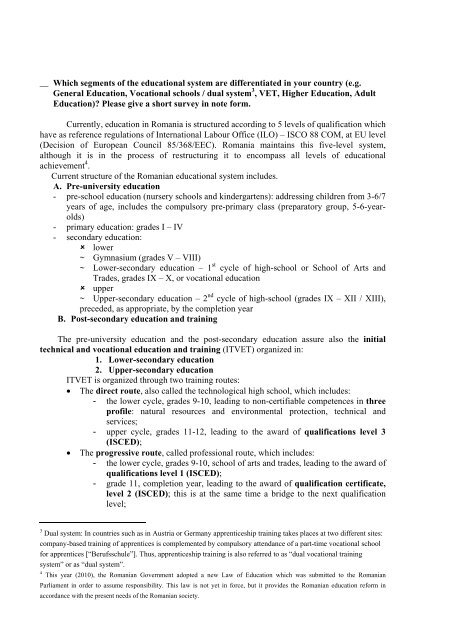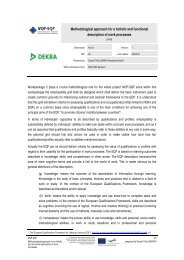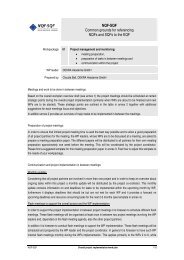Overview of National Qualification frameworks - Project-Nqf-Sqf
Overview of National Qualification frameworks - Project-Nqf-Sqf
Overview of National Qualification frameworks - Project-Nqf-Sqf
You also want an ePaper? Increase the reach of your titles
YUMPU automatically turns print PDFs into web optimized ePapers that Google loves.
__ Which segments <strong>of</strong> the educational system are differentiated in your country (e.g.General Education, Vocational schools / dual system 3 , VET, Higher Education, AdultEducation)? Please give a short survey in note form.Currently, education in Romania is structured according to 5 levels <strong>of</strong> qualification whichhave as reference regulations <strong>of</strong> International Labour Office (ILO) – ISCO 88 COM, at EU level(Decision <strong>of</strong> European Council 85/368/EEC). Romania maintains this five-level system,although it is in the process <strong>of</strong> restructuring it to encompass all levels <strong>of</strong> educationalachievement 4 .Current structure <strong>of</strong> the Romanian educational system includes.A. Pre-university education- pre-school education (nursery schools and kindergartens): addressing children from 3-6/7years <strong>of</strong> age, includes the compulsory pre-primary class (preparatory group, 5-6-yearolds)- primary education: grades I – IV- secondary education: lower~ Gymnasium (grades V – VIII)~ Lower-secondary education – 1 st cycle <strong>of</strong> high-school or School <strong>of</strong> Arts andTrades, grades IX – X, or vocational education upper~ Upper-secondary education – 2 nd cycle <strong>of</strong> high-school (grades IX – XII / XIII),preceded, as appropriate, by the completion yearB. Post-secondary education and trainingThe pre-university education and the post-secondary education assure also the initialtechnical and vocational education and training (ITVET) organized in:1. Lower-secondary education2. Upper-secondary educationITVET is organized through two training routes:• The direct route, also called the technological high school, which includes:- the lower cycle, grades 9-10, leading to non-certifiable competences in threepr<strong>of</strong>ile: natural resources and environmental protection, technical andservices;- upper cycle, grades 11-12, leading to the award <strong>of</strong> qualifications level 3(ISCED);• The progressive route, called pr<strong>of</strong>essional route, which includes:- the lower cycle, grades 9-10, school <strong>of</strong> arts and trades, leading to the award <strong>of</strong>qualifications level 1 (ISCED);- grade 11, completion year, leading to the award <strong>of</strong> qualification certificate,level 2 (ISCED); this is at the same time a bridge to the next qualificationlevel;3 Dual system: In countries such as in Austria or Germany apprenticeship training takes places at two different sites:company-based training <strong>of</strong> apprentices is complemented by compulsory attendance <strong>of</strong> a part-time vocational schoolfor apprentices [“Berufsschule”]. Thus, apprenticeship training is also referred to as “dual vocational trainingsystem” or as “dual system”.4 This year (2010), the Romanian Government adopted a new Law <strong>of</strong> Education which was submitted to the RomanianParliament in order to assume responsibility. This law is not yet in force, but it provides the Romanian education reform inaccordance with the present needs <strong>of</strong> the Romanian society.




